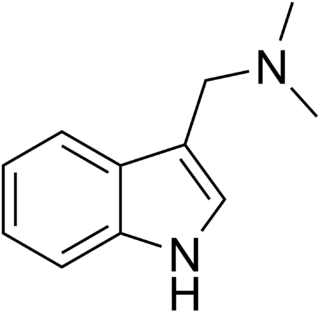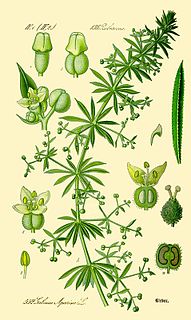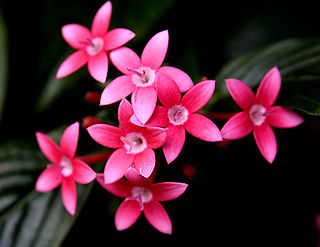
Griselinia is a genus of seven species of shrubs and trees, with a highly disjunct distribution native to New Zealand and South America. It is a classic example of the Antarctic flora. It is the sole genus in the family Griseliniaceae; in the past it was often placed in Cornaceae but differs from that in many features.

Iberis, commonly called candytuft, is a genus of flowering plants belonging to the family Brassicaceae. It comprises annuals, evergreen perennials and subshrubs native to the Old World. The name "candytuft" is not related to candy, but derives from Candia, the former name of Iraklion on the Island of Crete.

Gramine is a naturally occurring indole alkaloid present in several plant species. Gramine may play a defensive role in these plants, since it is toxic to many organisms.

Apterin is a furanocoumarin and the glucoside of vaginol. It has been isolated from the root of plants in the family Apiaceae such as members of the genus Angelica, including the garden angelica and Zizia aptera.

Plumbagin or 5-hydroxy-2-methyl-1,4-naphthoquinone is an organic compound with the chemical formula C
11H
8O
3. It is regarded as a toxin and it is genotoxic and mutagenic.
In enzymology, a hydroxyanthraquinone glucosyltransferase is an enzyme that catalyzes the chemical reaction

Galium aparine with many common names including hitchhickers, cleavers, clivers, bedstraw, goosegrass, catchweed, stickyweed, sticky bob, stickybud, stickyback, robin-run-the-hedge, sticky willy, sticky willow, stickyjack, stickeljack, grip grass, sticky grass, bobby buttons, whippysticks and velcro plant, is an annual, herbaceous plant of the family Rubiaceae.

Xanthoria elegans, commonly known as the elegant sunburst lichen, is a lichenized species of fungus in the genus Xanthoria, family Teloschistaceae. Recognized by its bright orange or red pigmentation, this species grows on rocks, often near bird or rodent perches. It has a circumpolar and alpine distribution. It was one of the first lichens to be used for the rock-face dating method known as lichenometry.

Ononin is an isoflavone glycoside, the 7-O-β-D-glucopyranoside of formononetin, which in turn is the 4'-O-methoxy derivative of the parent isoflavone daidzein.

Benzoxepin is an oxygen-containing heterocycle consisting of an Oxepin ring and a benzene ring. There are three isomers:

Patuletin is an O-methylated flavonol. It can be found in the genus Eriocaulon.

Barbigerone is one of a few pyranoisoflavones among several groups of isoflavones. It was first isolated from the seed of a leguminous plant Tephrosia barbigera; hence the name "barbigerone". Members of the genus Millettia are now known to be rich in barbigerone, including M. dielsiena, M. ferruginea, M. usaramensis, and M. pachycarpa. It has also been isolated from the medicinal plant Sarcolobus globosus. Barbigerone from S. globosus is validated to have significant antioxidant property. Barbigerone exhibits profound antiplasmodial activity against the malarial parasite Plasmodium falciparum. It is also demonstrated that it has anti-cancer potential as it causes apoptosis of murine lung-cancer cells.
Psoralea plicata is a herb species in the genus Psoralea found in Pakistan.

Violdelphin is an anthocyanin, a plant pigment, has been found in the purplish blue flower of Aconitum chinense, in the blue flowers in the genus Campanula and in the blue flowers of Delphinium hybridum. It is a flavenoid natural product, incorporating two p-hydroxy benzoic acid residues, one rutinoside and two glucosides associated with a delphinidin.
1,4-dihydroxy-2-naphthoyl-CoA hydrolase (EC 3.1.2.28) is an enzyme with systematic name 1,4-dihydroxy-2-naphthoyl-CoA hydrolase. This enzyme catalyses the following chemical reaction

Evariquinone is a chemical compound of the anthraquinone class which has been isolated from a sponge-derived strain of the fungus Emericella variecolor and from Aspergillus versicolor.

Nordinone (INN), also known as 11α-hydroxy-17,17-dimethyl-18-norandrosta-4,13-dien-3-one, is a naturally occurring steroid with antiandrogen properties isolated as a metabolite from the fungus Monocillium nordinii.
Asphodeline tenuior, the thin asphodeline, is a species of plant in the family Asphodelaceae, subfamily Asphodeloideae. It is native to the Caucasus, as well as from eastern Turkey and northwestern Iran. Within Russia, it is known from eastern Krasnodar Krai, Karachay-Cherkessia, Stavropol Krai and western Kabardino-Balkaria. It can be found on stony slopes and scree on limestone and sandstone, from elevations of 500–1,000 m. It is threatened by habitat loss and degradation, due to lime pits, slope terracing and cattle pasturing.
- Asphodeline tenuior var. puberulentaTuzlaci - eastern Turkey
- Asphodeline tenuior subsp. tenuiflora(K.Koch) Tuzlaci - Turkey, Iran, south Caucasus
- Asphodeline tenuior subsp. tenuior - north and south Caucasus

Knoxieae is a tribe of flowering plants in the family Rubiaceae and contains about 131 species in 16 genera. Its representatives are found in Tropical and Southern Africa, the islands in the Western Indian Ocean, the Arabian Peninsula, Tropical and Subtropical Asia, and Northern Australia.

Ploiarium is a genus of three species of woody plants in the family Bonnetiaceae. It is native to tropical forests and peat swamp forests in Southeast Asia including southern Indochina, Malay Peninsula, Sumatra, and Borneo. Species are generally slow growing with irregular flowering and fruiting cycles. Colonization of plants by arbuscular mycorrhizal fungi is known to improve growth and biomass.
















